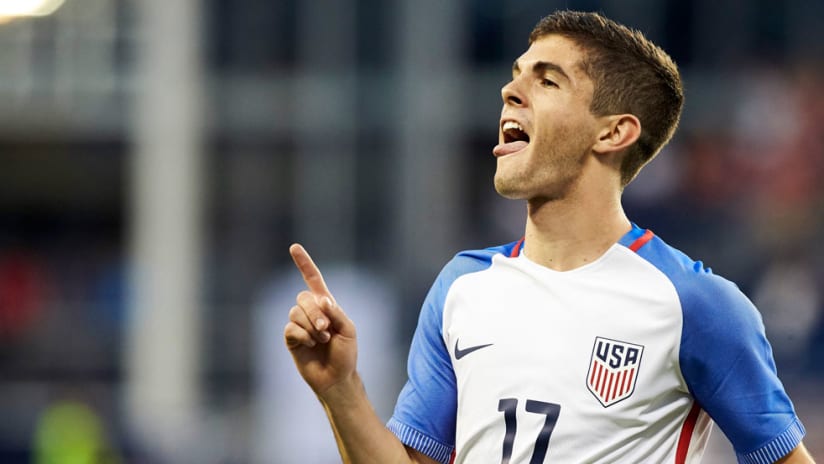If Christian Pulisic were plying his trade in MLS, the 17-year-old would be seeing even more action than he currently is at Borussia Dortmund.
That’s the message from MLS executives in response to US national team manager Jurgen Klinsmann, who wondered out loud to media members on Friday whether the Hershey, Pa. native would have received the same opportunity in MLS that he has in the Bundesliga with Borussia Dortmund (nine appearances in league play).
“Not only are the majority of top young American and Canadian players playing in MLS, but they’re choosing MLS over Europe for that exact reason — they get more opportunities here,” MLS Sr. VP of Player Relations and Competition, Lino Di Cuollo told MLSsoccer.com on Saturday. “All you have to do is look at the decision that Jordan Morris made in the offseason. He chose MLS over the Bundesliga because he wanted to play. And now he’s starting nearly every match and making an impact.
“Pulisic is an elite player and he was an elite player before he ever went to Germany. As with other elite players throughout the history of this league, not only do they see playing time, but they see more time here than they would overseas.”
Di Cuollo outlined the number of teenagers who got their start in MLS and went on to become US national team fixtures, including several in Klinsmann’s current pool: Michael Bradley (18), Tim Howard (19), Kyle Beckerman (18), Jozy Altidore (16), Matt Miazga (18) and DeAndre Yedlin (19). He pointed out how other teens used MLS to break into the national team set-up, highlighting former Real Salt Lake man Luis Gil, who became captain of the US Under-23 side during his MLS days.
As far back as 2001, an 18-year-old Landon Donovan sought out MLS for more playing time and more recently, Miazga, who is a New York Red Bulls academy product, made the multi-million dollar transfer to Chelsea after joining MLS as a teenager.
“Who would have given Christian Pulisic a chance here [in MLS] as a 17-year-old to play?” was the question posed by Klinsmann on Friday. "If you don’t give young players a chance, how do you want them to break through? Here in the US you call a younger player a rookie at the age of 22. At 22 in Europe, if you’re not broken through yet, you’re done."
“There’s no one and no league in the world doing more to develop the young American and Canadian player than MLS and its clubs,” Di Cuollo continued. “With the academy set-up at each of our clubs, the Homegrown Player initiative, our USL reserve teams and the Generation adidas program, we pride ourselves on being the league of choice for the young, aspiring professional in North America. To suggest otherwise is ignoring the facts.”
There are currently 18 teenagers on MLS rosters this year with defenders Tommy Redding (Orlando City) and Justen Glad (Real Salt Lake) each registering 10 appearances each so far in 2016. Just this week, the Vancouver Whitecaps gave 15-year-old Alphonso Davies the start in an Amway Canadian Championship semifinal second leg against Ottawa.
By comparison, a scan of Bundesliga rosters shows that together with Pulisic, only a handful of other teens today saw significant playing time in the recently concluded season, including Max Christiansen (12 starts, Ingolstadt), Nico Elvedi (12 starts, Borussia Monchengladbach), Suat Serdar (12 appearances, Mainz) and Kingsley Coman (20 starts) of Bayern Munich, the same club where US World Cup veteran Julian Green has struggled to see the field.
US youth national teamer Junior Flores, who's now 20 years old, beat Pulisic to Borussia Dortmund back in 2014, but he has yet to see any playing time for the first team and there were recent discussions about Flores making the jump to MLS.
Di Cuollo also noted that more than 160 Homegrown players have come through MLS youth academies over the years and their minutes have grown significantly in recent year from 12,000 minutes in 2011 to 54,000 in 2015. According to the Elias Sports Bureau, MLS's official statistician, teenagers in MLS played in a total of 19 matches back in the league's inaugural campaign in 1996. They played in 198 matches in the 2015 season.
League owners are committed to a long-term vision, according to Di Cuollo, including the soon-to-be-concluded evaluation of the MLS academy system which is set to provide metrics, parameters and best practices.
“We’re only getting started and we recognize there’s more to be done,” DiCuollo said. “But with the progress we’re making and the results we’re seeing, there’s no doubt that MLS will continue to be at the forefront of developing players for both the US and Canadian national teams."













